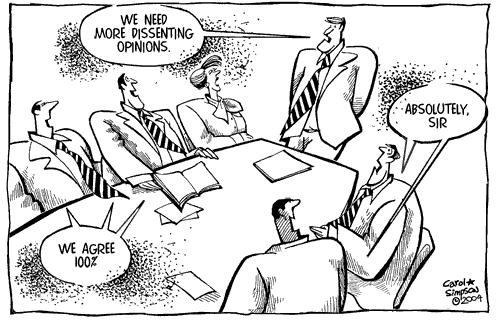Avoiding Groupthink: How a Consultant is a Professional "Frenemy"

Sometimes a project goes just perfectly. People like you and trust you, they laugh at all your jokes, and they accept your ideas. Development is moving ahead on schedule, and, best of all, you genuinely believe you’ve thought through every variable and allowed for every contingency.
And then six months later, when the project has failed, all you can think is, “Why didn’t I catch any of those issues?”
Just like conflict can be a good thing, harmony has a nasty evil twin: Groupthink. Before it became a cliché found in management books, it was a real psychological phenomenon first examined after WWII. Groupthink makes awful ideas seem good and blinds people to risk, and it helps explain some of the dumbest calls by smart people – from Pearl Harbor to New Coke to the recent cover up at Penn State. It’s especially toxic for consultants because unlike the ordinary instinct to conform, groupthink makes bad moves feel intellectually as well as emotionally satisfying. People feel good when they all agree, and the rational ones still think they’re behaving rationally.
A trickier task for the consultant than avoiding groupthink yourself is realizing when it’s happening and diffusing it when a group gets suspiciously agreeable. Here we have a “consulting catch 22”: let a team trust you too much, and team members may lose their own perspectives, fall into groupthink and forget their critical thinking skills; but make a habit of regularly shaking things up, and you risk being dismissed as stubborn and contrary.
Fostering critical thinking isn’t about being the resident devil’s advocate. It takes a culture of candid discussion and feedback loops in the entire group. Here are some strategies to maintain reason when things get a little too harmonious:
- Limit group-wide collaboration in the early stages of a project. Encourage people to work on tasks alone or in small teams before coming together as a group.
- Design meetings with a structure and etiquette that encourages questions and candid opinions. Follow your own rules and encourage the constructive critics.
- Be your own enemy. Go out of your way to support and discuss views that conflict with yours.
- If people recognize you as a leader, reconsider voicing all your opinions during open discussion. They may not be necessary for the room at large to hear, and they may influence others’ conclusions.
- If one (or more) does not naturally appear, assign a designated devil’s advocate for team discussions. If it’s more comfortable, change up who it is for every meeting or project phase.
- Make it a rule to develop backup plans or alternative solutions even if the current scheme seems perfect.
- Throw out some bad ideas on purpose, and see if anyone notices. Don’t make them so bad that you risk your credibility, but use them to gut-check whether everyone is paying attention.
Remember, when things seem to be going too well, they probably aren’t. It may just be that your team has become too agreeable. Given human nature, it’s usually not difficult to encourage constructive dissent, and it’s a great tool for a consultant to have in their skillset.
